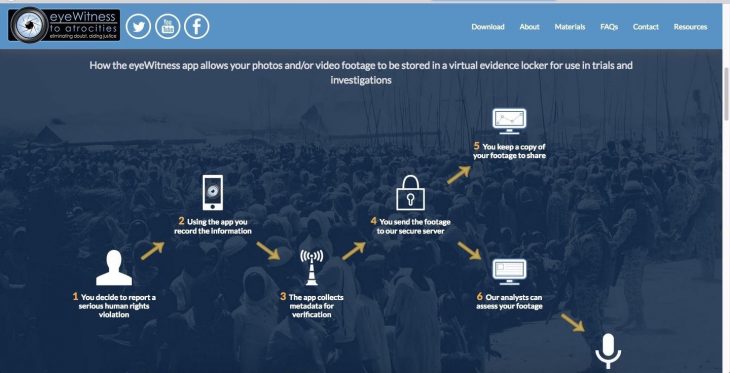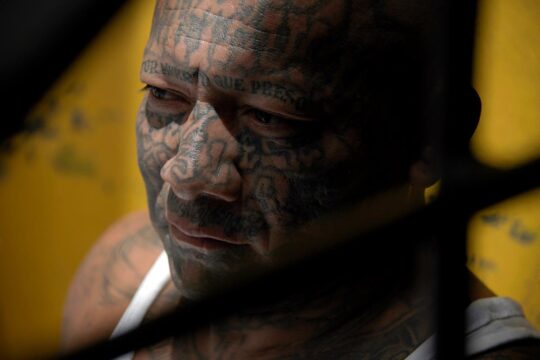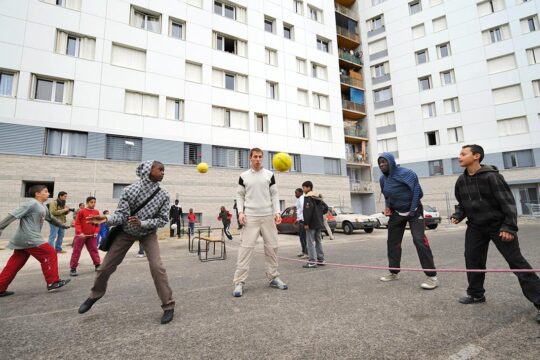EyeWitness won the Geneva Centre for Security Policy (GCSP) Prize for Innovation in Global Security last month in Geneva. eyeWitness provides human rights defenders, journalists, and ordinary citizens with a mobile app to capture verifiable video and photos of international atrocity crimes to be used as evidence in investigations or trials.
The use of footage as evidence of crimes against humanity or war crimes is not unknown to international criminal courts. For instance, the NGO Human Rights Watch compiled footage of the stadium massacre in Guinea in order to support the ongoing investigation. But if some footage has proved to be useful in courts, the accessibility of social media has rendered their use and selection complicated, when they are not deemed inadmissible. A group of lawyers from the International Bar Association (IBA) has been addressing this issue since 2010, the result being a mobile app named eyeWitness to Atrocities. Wendy Bett, the project director of eyeWitness, tells JusticeInfo about its development, and its utility in the context of growing instability worldwide.
JusticeInfo: Where does the idea of creating this app come from? Is there a need today to collect more evidence when prosecuting international crimes?
Wendy Betts: In November 2010, UK broadcaster Channel 4 obtained harrowing footage apparently showing Sri Lankan troops executing Tamil prisoners. Mark Ellis, Executive Director of the International Bar Association (IBA), was one of the international lawyers asked to examine the evidentiary value of the video. The Sri Lankan Government rejected it as fake. This became a catalyst for the idea to develop a verification tool to enable images to be verified and used more easily in a court of law. The result is eyeWitness to Atrocities, a mobile camera app designed to authenticate and securely store footage of gross human rights abuses, while allowing users to remain anonymous.
The eyeWitness to Atrocities app was developed to help people capture images in a format that is more useful to courts and investigators. Many photos and videos relating to international crimes that are posted to social media are missing basic key information that makes it difficult to use them in court. The eyewitness app was designed to tackle this problem.
JI: How was this project funded?
WB: The eyeWitness project is funded by the International Bar Association, which has provided 1 million USD of seed funding.
JI: What is the difference between footage shared on social networks or media and one collected by eyeWitness?
WB: Many photos and videos posted to social media do not include a verifiable time, date, location, source or information about whether they have been edited. This basic information may be missing or incorrect. In contrast, images taken with the eyeWitness app include a verifiable GPS time, date and location. All come from a registered instance of the app. Each image includes a unique numeric code which can be checked to show that the image has not been altered. Users can safely store an original copy of each image in the eyeWitness secure server hosted by LexisNexis. This acts as an offline evidence locker and protects the chain of custody required in criminal cases. The eyeWitness organisation can verify images on request or seek an appropriate accountability body to act on evidence if local partners are not already taking action.
JI: What is your strategy for your app to be widely used by citizens in areas where atrocities are more likely to occur? Did you for instance hand out smartphones in these areas?
WB: The eyeWitness app is free and available for anyone with an android smartphone to download. We have reached out to those individuals and organizations documenting international crimes through social media and trained local partners. EyeWitness does not provide smartphones.
Smartphones are increasingly used all over the world, including in places where atrocities are taking place. Citizen-captured video is on the rise. In 2016 the number of smartphone users reached more than 2 billion, a third of the world’s population. These trends present new opportunities to hold the perpetrators of international crimes accountable.
JI: How can an ordinary citizen understand what kind of evidence would be useful in courts for what kind of crimes?
WB: The eyeWitness project focuses on atrocity crimes. However, we do not expect everyone to have detailed knowledge of the legal elements of international crimes. For example, someone documenting a single human rights violation may not know if it is part of a widespread and systematic attack on a civilian population rising to the level of a crime against humanity. EyeWitness has legal analysts who review all footage that we receive to catalogue, tag, and determine whether it may be relevant to atrocity crimes. EyeWitness also targets its dissemination to organizations that are already documenting crimes, and therefore have an understanding of the type of information that is required.
JI: When developing this project, did you discuss it with national and international judges to make sure that the evidence collected from it would be admissible?
WB: At the start of the project the International Bar Association commissioned research on the admissibility standards of different international, regional and some national courts. The IBA consulted with legal professionals including those at the International Criminal Court. Although there are differences in each jurisdiction, there were also certain shared core principals. The eyeWitness to Atrocities App is designed to address these core reliability requirements.
JI: What are the next steps in developing this project?
WB: EyeWitness will continue to reach out through our website, traditional media, and social media to raise awareness of the app and to partner with those documenting international crimes around the world.





